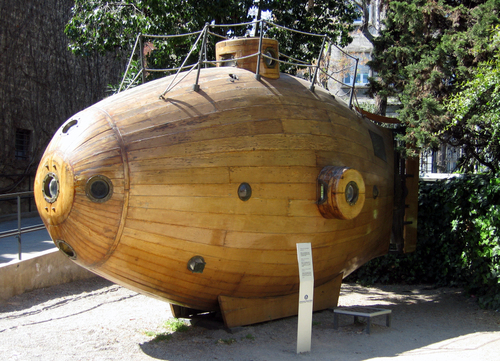
Constructed from wood by Narcis Monturiol I Estarrol in the late 1800s, the Ictineo wooden submarine was built stupendously. The Ictineo II, was still constructed from wood in when it was built in 1867. It contained a combustion engine and a strong shell design that helped catalyze ideas that were further pursued in the 1940s.
Monturiol’s name for the submarine derived from the Greek words for fish and ship. The body of the submarine was constructed entirely from olive wood that was bolstered with oak rings, sheathed in 2 mm thick copper. The interior was 23 feet long, barely enough room for the underwater crew including four men who crank-powered the vessel and the captain. The double hull and spherical shell of the submarine used remarkably modern technology to resist water pressure. The outer shell enabled the submarine to remain safe while underway, allowing the ship to hydrodynamically steer. The ship’s hull contained four ballast tanks that were manipulated from inside the cabin by valves that let in water or forced air inside. The pitch was controlled by a weight in the submarine’s interior while in motion. These weights could be instantaneously dropped if immediate surfacing was required. This control over the buoyancy enabled Ictineo to embark on deep adventures way under the sea, venturing down further than any other submarines at the time. For a maximum of 2 hours, the submarine could remain underwater.


For underwater propulsion, the submarine went underway from a helical screw that was manually turned from inside the cabin. The pedal power used inside the Ictineo required many crew members to achieve an evenly slow pace.
The Ictineo II was created when Ictineo was accidently destroyed. Ictineo’s brother was shortly developed, using steam power in 1867. To combat the problem of inadvertently converting the submarine into an underwater oven, Monturiol developed a special chemical furnace. This apparatus enabled a reaction between potassium chlorate, zinc, and manganese dioxide, a process involving ample heat to boil water that allowed the steam engine to generate power. Interestingly enough, Monturiol discovered that this reaction released the by-product of oxygen. The system of anaerobic propulsion helped with air supply and mechanical power for the submarine. The Ictineo II provided its own oxygen supply without having to use a snorkel like models of the Nautilus.
Unfortunately, Montuiorl never patented his ideas, and never received recognition where credit was due for his invention. Even though this submarine ranks extraordinarily high on the scale of coolness, these prototypes were never fully commonly used. Montuiorl died a poor man. Quelle dommage! 
Story via Low-Tech
Advertisement
Learn more about Electronic Products Magazine






